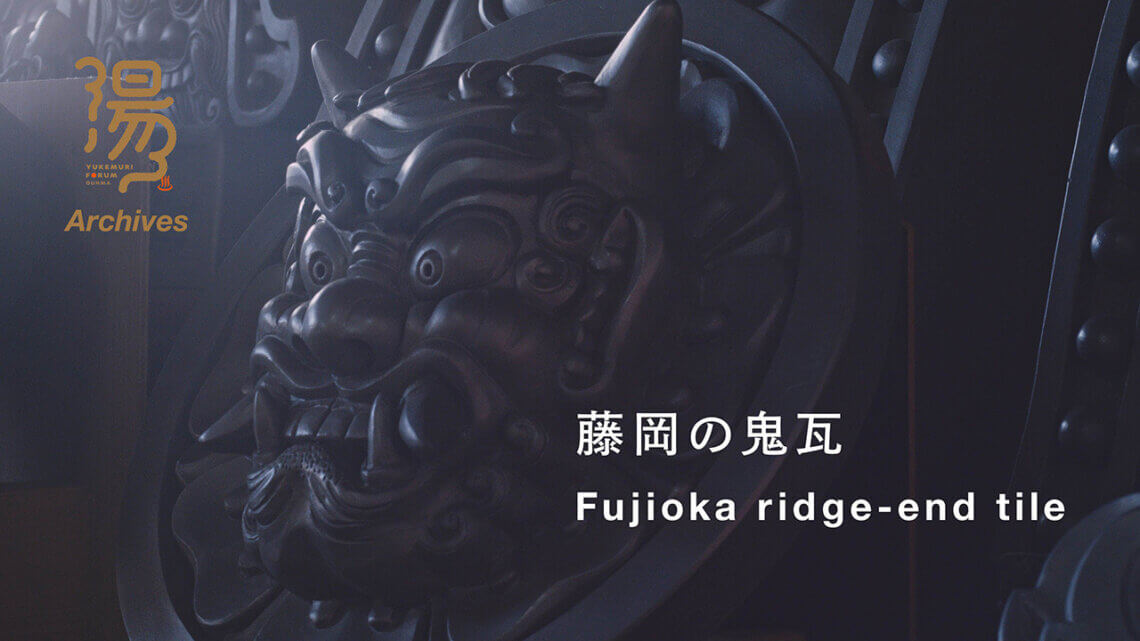- ARCHIVE
【湯けむりアーカイブス】瓦に適した藤岡の土、熟練の技で作る迫力の顔。現代の名工、山口鬼瓦店。
シリーズ『湯けむりアーカイブス』では、群馬県内各地に根付く固有の文化や伝統、産業などを見つめ直し、地域の求心力であるその価値を丹念に紐解いて記録。未来へとつなげます。
ーーー
瓦製造に古い歴史を持つ藤岡市で、手彫りの鬼瓦を製造する山口鬼瓦店。山口茂さんはその五代目です。今では数少ない、卓越した技術を持つ『鬼師』として、数々の歴史的建造物も手がけ、2012年には現代の名工に選ばれました。角も牙も大振りな鬼の顔が山口家の代々の特徴で、茂さんが生み出す鬼瓦も、全国の鬼師から“からっ風のおっかない顔”と評されています。
The city of Fujioka has a long history of making roof tiles. Yamaguchi Onigawara Shop makes hand-carved ridge-end roof tiles (onigawara). Shigeru Yamaguchi is the fifth-generation to run the business. He’s one of the few skilled onishi—literally, demon masters—remaining. He has worked on numerous historical structures, and in 2012 was named a “modern master craftsman” by the Ministry of Health, Labour and Welfare. For generations, the faces of demons on the Yamaguchi clan ridge-end tiles have been recognizable by their large horns and fangs. The tiles created by Shigeru have been praised by his peers throughout the country as “the ferocious faces of the demons behind Gunma’s karakkaze winds.”
瓦に適した藤岡の土は、柔らかく腰がないため取り扱いには熟練の技が求められますが、そのぶん、焼き上げると水分や空気の調節に優れた強い瓦となります。また、薪窯で焼くことで表れる、上品で美しい燻し銀の風合いも大きな魅力です。
Fujioka clay used to make the tiles is soft and lacks a certain firmness. A craftsman must be skilled just to work it. When fired, though, the resulting tiles can adapt well to changes in water and air. Another feature of the clay is the elegant silver matte hue the tiles take on when fired in a wood-burning kiln.
先代である父の喜代蔵さんは東京・増上寺本堂の鬼瓦も手がけた稀代の鬼師でした。様々な難しい装飾の注文に取り組む名工の背中を見ながら、若き日の茂さんは仕事の後や休日にも鬼師の修練に励むようになりました。直接手ほどきを受けることはなく、日々の喜代蔵さんの仕事を見続け、自分のものとするべく考えて、匠の技を習得してきたそうです。
Shigeru’s father Kiyozo was an onishi of rare talent who did the roof-ridge tiles on the main hall of Zozoji Temple in Tokyo. As a young man, Shigeru worked under his father, and trained for master status after work and on his days off. He was never taught how to design or create the tiles, rather he watched his father at work. Shigeru says that he managed to learn the craft out of sheer determination.
約200年続く山口鬼瓦店では、昔の鬼瓦の型紙なども先祖代々受け継がれています。鬼瓦は屋号や名前などの文字も図案化し立体的に彫るため、幅広く奥の深い造形技術が必要となります。茂さんは時に先人の図案も参考に“粋な形”を追究して瓦を彫ります。
All of the paper patterns generated by Yamaguchi Onigawara throughout its 200-year history have been saved. Family and business names go on ridge-end tiles. The style of the characters is first drawn on paper and then converted into three-dimensional form when carved into clay. The process requires an enormous range and depth of skills. Shigeru goes back to look at the designs of his predecessors when searching for just the right style and level of sophistication.
茂さんが35歳のときに先代が他界。前例のない仕事に挑み続けろという言葉が、5代目への遺言でした。 「職人は、やったことねぇとかできねぇって言って逃げたら、腕が伸びねぇしそこで終わりだ。それに挑戦して行かなけりゃだめだ。」
Kiyozo died when Shigeru was 35. His father’s parting words to him were to continue to take on new challenges, striving to do work that was without precedent. “If an artisan turns down a request because it’s something that’s never been done before, that’s just a missed opportunity. I refuse to pass on chances to do something new and get better at what I do.”
ーーー
<鬼瓦作りの工程>
1.粘土づくり:掘り出して1~2年寝かせた原土を、水分調整し土練機にかけ、さらに手で捏ねる
2.図案引き:鬼瓦の図案を描く
3.造形:下絵をもとに粘土の感触を確かめながら手で大まかな形を作っていく
4.仕上げ:大小のヘラを使って形を整え表面を磨く
5.乾燥:数日陰干しした後、2〜3日天日乾燥する
6.焼成:薪のダルマ窯で1000℃前後で一昼夜焼成する
7.窯を密封して一日置くと銀色に輝く鬼瓦が完成
<Process for making ridge-end tiles>
1.Take clay that was dug up 1 to 2 years before, adjust water content, knead with a kneading machine, and then by hand.
2.Draw a design for half of the tile.
3.Create a rough version of the tile using the draft design to get a feel for the clay.
4.Refine the design using scrapers of different sizes, then polish the surface.
5.Dry for several days in the shade, and then 2–3 days in the sunlight.
6.Fire at about 1000℃ for 24 hours in a traditional wood-burning daruma-kiln.
7.Finally, the kiln is hermetically sealed for one day to obtain the brilliant silver color characteristic of the ridge-end tile.
映像制作:岡本 憲昭
インタビュー/解説:武井仁美
